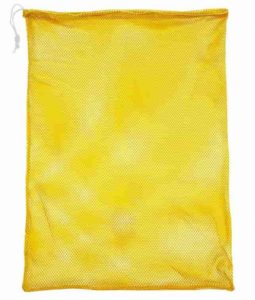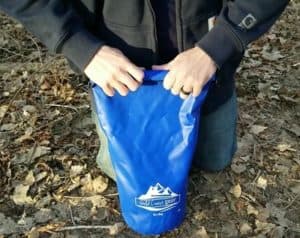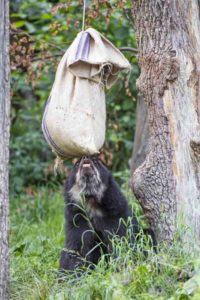Nothing can ruin a camping morning more than noticing all your food is gone. From just a one-night stay at your favorite campsite to days in the woods. It’s our responsibility to keep our camping food safe from wild animals. Food safety prevents small and large animals from getting too comfortable with humans, making them more aggressive.
I’ve camped in areas with seemingly no bear activity. But just because you don’t get a bear one night doesn’t mean they’re not around. If your house doesn’t get burglarized tonight doesn’t mean there’s not a thief in the neighborhood.
How to Protect Food While Camping
Staying at a campsite or backpacking is going to have the same general guidelines.
- Keep food and other tasty items (such as toiletries and trash) out of your tent.
- Don’t cook at your campsite.
- Store or hang food 100 feet from camp. Keep your food downwind of you, so the smell isn’t going over your campsite.
- Keep an eye on your food during the daytime; small animals will get to it quickly.
- Avoid using your clothes as a dishtowel and napkin.
- If a bear does get the bear canister or bag, let them. They will get frustrated and give up eventually.
This also includes any things you cook with, such as a pan or cooking spatula. Empty sport drink containers and throw-away wrappers from energy bars.
Don’t keep a bear canister or bag inside your pack! A bear will take your backpack with the canister inside.
Options to Keep From Safe From Animals
- Bear Bag – These are more robust bags that are difficult for animals to rip open. You’re going to hang these bags, but they offer extra protection.
- Hanging a dry bag – Dry bags are great for keeping all your gear dry, but an animal will rip them open easily.
- Bear Canister or Bear Barrel – We’ll get into the differences in this article.
Let’s rip into bear-resistant canisters first.
Bear Canisters
What is a Bear Canister
It’s merely a Bear-resistant food storage container. Bear cans are another name for them, but they all are hard-shelled containers used by backpackers to protect their food from bears and other animals. I’ve typically had more of a problem with raccoons than bears, but the protection is the same.
The typical bear canister is going to weigh two to four pounds depending on material and size. The sizes range from smaller 2-liter to larger 11-liter containers. Beware of the extra weight, and you might want to get a larger one for a group of hikers, instead of carrying one canister each.
Canisters are a time saver. After a day of hiking, making dinner, it’s quick and easy to move the canister 100 feet away for the night. For a bear bag, you’ll need to find an excellent place to hang food, through ropes, and pull the bag up. This can be aggravating after hiking and eating dinner.
Bear canisters add extra utility. I often use them as a seat or a small table. Use them for gathering water from a stream and take it back to camp and filter the water there. Bear canisters can be a pain to carry.
I know when I first brought one of these, I thought about the extra weight and bulk that could have been used for something I left behind at home. There are advantages and disadvantages, but you might want to use one even if the park doesn’t require it.
Best Bear Resistant Canister
The BearVault BV500 Bear Resistant Food Canister has been known as one of the best. It’s tested and approved by Grizzly (IGBC) and Black Bear (SIBBG) testing facilities. The ridges on the side are made to tie a rope around, then attach at the top of your hiking backpack. While this can fit inside your pack it’s quite large at 11.5 liters. At this size, it’s perfect for a group hike or a 4 to 7 days extended hiking trip. Check availability on Amazon here.
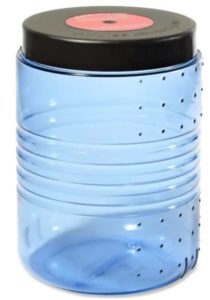
The BearVault BV450 Bear Resistant Food Canister is smaller than the one above. This one will be more convenient to carry inside your pack, yet still large enough for a few people in your hiking group. It comes in at 7.2 liters. It’s made from the same material, also tested and approved by Grizzly (IGBC) and Black Bear (SIBBG) testing facilities. Check availability of the BearVault BV440 on Amazon here.
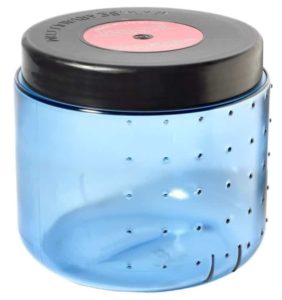
Lightweight Bear Resistant Container – 1.9 lbs
The Bearikade Weekender is the lightest bear-proof container I could find that’s not too small. It’s sized for 2 people going on a weekend trip. The volume is 650 cubic inches. This is also by far the most expensive one on the list at $300. The high price is from the material; made out of composite carbon-fiber cylinder with high strength epoxy. You can check it out on Bearikade website here.
Bear Barrel
A bear barrel is much like a bear canister, but the top attaches differently. A bear canister will have a tight screw-on lid. The lid of a bear barrel can be locked or removed with a coin, a key, or a similar tool. Bear canister and barrel terms are used interchangeably, but some areas require barrels for extra protection. It’s been reported in the Adirondack Mountains that bears have figured out how to open screw-on canisters. This area now recommends key lock bear barrels.
Best Bear Resistant Barrel
The Backpacker’s Cache – Bear Proof Container uses two screws at the top to secure the lid. The lid needs to be closed and opened with a key or coin. If you have ever rented a bear-proof container at a national park, it was probably this one. It’s tested and approved by Grizzly (IGBC) and Black Bear (SIBBG) testing facilities. While a bear bag or the BearVualt is a good choice, the Backpacker’s Cache is the most highly recommended food container. Check availability on Amazon here.

Cons of Bear Resistant Containers
- Bulky big container. Even as you eat food throughout the days, it’s the same size.
- Extra weight.
- A small hiking backpack won’t be able to hold it.
- Difficult to fit large items in.
- More expensive than hanging a bear bag.
- They are not usually airtight. An animal will still be able to smell what’s inside.
Bear Bags
Ultra-strong bags that have been shown to keep bears from getting your food. The reason people choose a bag over a canister is to save weight and money. Also, since the sides are not rigid and solid as the bear can, the bag will fold down as you remove food. This is convenient if your hiking trip lasts a few days.
Ursack makes the leading bear bag, and they sell an aluminum crush resistance liner. They say this is the best of both worlds, adding the convenience of a bag, with the protection of a canister. While all the reviews are suitable for the Ursack aluminum crush resistance liner, I think it’s wildly overpriced at this time. Check availability of the aluminum crush resistance liner on Amazon here.
While this bag will protect animals from getting your food, nothing is stopping them from crushing everything inside, making a big mush. This is if you don’t get the aluminum liner. A bag is also easy for a bear to take with them far from your camp.
Cons of Bear Resistant Bags
- Some national parks don’t allow them.
- A bear or large animal could crush it (without the aluminum liner) or even carry the bag away. It’s not much use if you can’t find the bag.
- Requires more work to hang.
- Not waterproof (see a trick for this down below).
Best Bear Resistant Bag
The Ursack Major Black Bear Bag is made from bulletproof UHMWP fabric. It’s lightweight at 7.6 oz with a capacity of 10.65 liters. Combine with an odor barrier bag, and an aluminum liner serves to make the bag more durable. These are sold separately from the bear bag itself.
Without the optional aluminum liner, your food may be crushed, ripped, or punctured. The OPSAK odorless storage bag can be found here. This bear bag has been shown to prevent bears from getting your food, but there have been complaints about bears or large animals turning the food to mush. These are reviews from people that didn’t have the optional aluminum liner. Check availability of the Ursack Major bear bag on Amazon here.
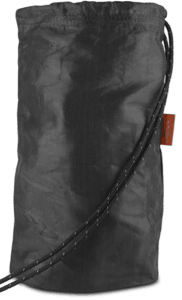
Bear Bag with Dry Bag or Mesh Bag Trick
The biggest complaint is that bear bags aren’t waterproof. As the bag is hanging from a tree, the rain will seep inside, possibly ruining your food. There are two ways to prevent this.
- Put the bear bag upside down inside a mesh bag. By doing this, the rain will roll down the bottom of the bag with the opening on the bottom. Water will not puddle inside. A mesh bag is convenient to have backpacking anyways, and they are lightweight.
Hang your bear bag upside down inside a mesh bag 2. Put the bear bag inside of a waterproof dry bag, then hang it. Most hikers use dry bags, so you’re probably going to have one with you anyways. This is the best waterproofing method I have found. Dry bags are robust so they can take a lot of weight. Larger 20L dry bags should have room for all of your groups’ food.
How to Hang Your Camping Food
The first thing you should be thinking about when hanging your food is locating a tree around 100 ft from your campsite or 300 ft in grizzly country. Ideally, you want to look for a limb that is 18 to 20 ft off the ground. Preferably the limbs should be about 4 inches in diameter or smaller to prevent it from being able to support a bear’s weight.
Next, fill a small stuff sack with a rock, or tie your rope around a rock. Then attach the cord and simply toss the rock sack with the cord attached up and over the selected branch. Make sure all other camp members are not in the immediate direction of where you will be throwing the rock sack. You may consider securing the other end of the cord to help prevent it from becoming stuck in the tree once the throw is complete.
Remove the rock sack from the cord and then attach the cord to a carabiner on the food bag before hoisting your bag. You’ll want to make sure you place all your food trash and any items with a scent into the roll-top food bag.
Next, hoist the bag up, making sure it’s at least six feet from the tree’s trunk approximately six feet below the supporting branch, and at least 12 ft off the ground. Once the bag is at the appropriate height, you can tie the other end of the cord at a suitable anchor like a rock or another tree.
If you’ve never hung a bear bag before it’s tricker than you think. It can help to practice first before trying to do it when you’re tired, in the dark, with a headlamp, while it’s raining, with a bear nearby.
Pacific Crest Trail (PCT) Bear Bag Method
Alternatively, you can use the PCT method. This method involves running the cord through the carabiner on the food bag and then pulling the bag up to the selected branch. Next at eye level, you’ll attach a small stick or steak to the cord using a simple clove hitch.
Once the stick or steak is attached, slowly let the food bag slide down until the stick or steak hits the carabiner. This will prevent the food bag from lowering any further. The food bag is now secure and can be suspended overnight.
Two Tree Hanging Bear Bag Method
Sometimes finding the perfect tree branch to hang a bag from is not possible. You will have to use the two tree hanging method utilizing two shorter branches on two different trees. First, start by finding two trees that are at least 20 ft apart. Next, throw one end of the cord over a shorter branch on one tree.
Then throw the other end of the cord over another shorter branch on the second tree. Now attach the bear bag to the center of the cord with a carabiner. Tie the first end of the cord to the tree, then pull on the other end of the cord to hoist the bag up to the appropriate height. Tie the second end of the cord to the tree.
These three methods are explained in this video.
How is a Bear Canister Tested
Testing starts when a manufacturer brings the canister or bag to a Grizzly and Wolf Discovery Center or GWDC for short. The container is placed in a bear habitat for 60 minutes. Bait is placed inside, and if the bears’ can’t obtain food from it, the container gets a “Bear-Resistant” certification.
If the container does not pass, it can always be modified and tested at a later date. Testing helps humans and wildlife separate, making life safer for both humans and animals.
This testing was developed through a cooperative effort among the Montana Department of Fish, Wildlife and Parks, U.S. Forest Service, IGBC, and the Grizzly & Wolf Discovery Center. As of right now, the GWDC is the only facility approved for testing products to be certified as “Bear-Resistant.”
Link to the GWDC if you want to learn more.
Here is a video of bears testing different containers.
Bear Resistant Coolers
If you’re looking for a larger container that will keep food cold for a few days, a bear-proof cooler can do the trick. Not only will a cooler keep animals out, but they are also lockable to keep humans out of your food. Having a tight seal and locking lid is not enough. The cooler needs to be clarified by the GWDC.
While on the pricier side of coolers, the YETI Tundra 45 Cooler comes highly recommended. This cooler has thick walls for excellent ice retention, with the lid being lockable. It comes in many colors and holds 26 cans with the recommended ice ratio. Check availability of the YETI Tundra 45 Cooler on Amazon here.
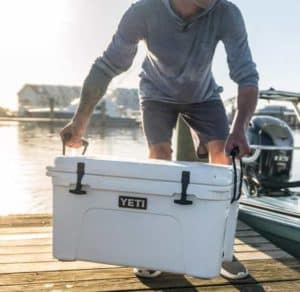
Orac is another company that makes bear-resistant coolers. This is one of the more cost-effective coolers that performs well and is certified to keep bears out. It features a 26-quart storage capacity with a tight lid seal. They also claim this cooler will keep ice for up to 7 days. Check availability of this ORCA cooler on Amazon here.

Food Storage at a Campground
During the day, keep all your food in a large bear-resistant ice chest. When you’re going for a hike, put a lock on the ice chest to prevent humans from getting inside. Also, include all little food items such as energy bars and drinks.
At night keep your food in a safety bin if one is available. If not, hang your food or use a bear canister moving it at least 100 ft away from your tent. Even if an ice chest seems challenging to open, raccoons are well adapted to these. It’s best to use an ice chest that has been bear-resistant certified.
How to Keep Food Safe While Backpacking
Check to see what kind of food containers are required in the area you’ll be hiking in. National parks and other areas have regulations on the types of containers you can bring. Some required bear canisters and not just bear bags.
Hanging food in many regions is discouraged as well. If you decide on hanging a food bag take the time to do it correctly.
Can Bears Smell Food in Cars?
Yes. Bears have a fantastic sense of smell. Bears are adapted to getting into cars and finding what smells so good. Not only will seeing a bear in your car freak you out, but they can also tear the inside apart as well.
In many parks, you’re not allowed to keep food inside your vehicle. This applies to the bed of a truck during night time too.
Are Bears Attracted to Human Urine?
Drinking coffee, tea, and alcohol throughout the day results in some stinky pee. Bears can smell seven times better than a dog, and they can small everything you ate and drank in your urine. Always pee away from your campsite.
If you know of any other tips for keeping food safe from bears, please let me know down in the comments. I’m always happy to learn new tricks for keeping camping food safe or good practice to keep bear away from my campsite.


